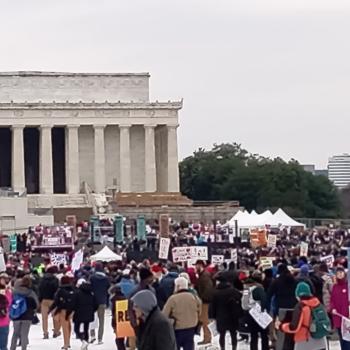Vox Nova is pleased to present the following guest post by Lillian Vogl.
What does it mean to be “centrist”? It alludes to being in the center of a political map, but to understand what that means we need to agree on the map.
The most traditional political distinction is between “right” and “left,” a one-dimensional spectrum that could place anyone who doesn’t fit comfortably near one of the poles as being “centrist.” The problem with this conception is that the left and right poles are extremely reductionary, and the axis seems to shift quite a bit. Originally “right” referred to representing the interests of the upper classes and “left” referred to representing the interests of the lower classes. Now “right” has taken on a religious-populist flavor, while elected officials of the “left” tend to be secular technocrats, both of which claim to look out for “the little guy” but are actually controlled by big corporate donors. There is no cohesive “center” in this map; only a collection of malcontents with widely varying disagreements with the two dominant parties, some principled, some self-interested, some based on taste or learned bias. In this conception, the canard that “the only thing in the center of the road is roadkill” makes some sense. Unfortunately, it is the interests of the less-privileged in society who find no champion in the present configuration and who end up flattened and destroyed.
A more nuanced two-dimensional political map emerged a few decades ago that runs authoritarian to libertarian along one axis, and economic right (capitalist) to economic left (socialist) along the other. Here “centrism” begins to emerge as a more attractive space in which dialog and compromise can emerge. However, there are still considerable weaknesses to this model, which may explain why elected officials have continued to trend to polar extremes instead of converging in the middle.
A key criticism of the two-dimensional model is that it equates religious values with authoritarianism, and licentiousness with voluntarism. Thus a Catholic anarchist like Dorothy Day still finds no comfortable spot on this diagram (and may be wrongfully placed in the center because religious values are “scored” as cancelling out commitment to non-violence), while anti-abortion democratic socialists can get lumped in the same quadrant with neo-Nazis. Because people who appear to be similar on the political map may yet have some radically different values and aims, they do not easily ally with each other, so political influence continues to gravitate toward the poles.
I propose we need a new, 3-dimensional model to represent different views about how society should be organized for the “common good.” The map thus becomes a sphere (or perhaps a cube for easier visualization).
The first question that must be answered—forming a vertical axis—is what is meant by “good”? Is “good” a purely spiritual concept, such that the person is largely indifferent to secular political circumstances? Is “good” a purely material concept, pursuing Pareto optimality and relegating spiritual concerns to private preference? Or is “good” a balance of the two, in which justice demands concern for the material well-being of humanity and/or the environment as part of fidelity to a Creator or other higher power? Along this axis, a centrist position clearly holds the ethical advantage over indifference to material needs or materialism.
The next question—one that is implicit in the classic right-left spectrum but not well-articulated—is the nature of responsible citizenship. Is the “good” achieved primarily by each individual taking responsibility for their own actions toward the good end, or is it achieved by each committing their efforts toward a collective good? Should personal achievement be highly rewarded by society, or should surrender of one’s privilege and preferences to the collective good be given the highest honor? Along this axis, the dangers of collectivism are well-known, but the individualism of American culture is more recently coming into negative light. Extreme individualism, and the competitiveness it requires, leads to society-disrupting economic inequalities, family breakdown and anemic community connections, destruction of the weak and vulnerable, and poor mental health that sometimes explodes into violence against oneself or others. Here too a balance of personal and collective responsibility seems to best promote human flourishing.
The third axis represents how society is to be animated to pursue the good. On one end of the axis is authoritarianism, in which elite decision-makers use threats to gain compliance from the members of the polis. In extreme authoritarianism, the threat is one of violence and/or incarceration against all non-conformists. In softer versions of authoritarianism, a regulatory state micromanages many activities and fines transgressors, or tax policy is used to mold behaviors with punitive rates on certain undesirable activities and large tax breaks for certain preferred activities. The opposite of authoritarianism is voluntarism, in which there are no carrots or sticks to wield, but proponents hope to motivate desired behavior purely by persuasion—appeals to conscience or science—and deter undesirable behavior purely by allowing natural consequences to occur. Unfortunately, voluntarism tends to allow those with more resources and less conscience to ignore and even dominate the poor and vulnerable.
In the center between authoritarianism and voluntarism lies the democratic rule of law, in which the members of the community—not a self-appointed (or ostensibly God-appointed) elite—decide what should be required of members of society and what should be left to free choices. Also implicit in this approach is a requirement of due process under the law, in which the application of carrots and sticks is limited by some kind of societal necessity for them, as well as some kind of fair trial before applying punitive measures.
The more the center of gravity of the political sphere tends toward the center, the more stable it is. If there is general agreement about the validity of both material and spiritual values, responsibility for both individual behavior and the collective distribution of goods, and democratic rule of law to organize, questions of policy and societal change can be incremental and less threatening to people. Society can more smoothly “roll with it” when circumstances change due to developments in technology or knowledge, or even stressors caused by hostile forces or natural disasters. Debates over policy change can center more around evidence and logic when values aren’t too far apart.
When members of the body politic start clumping around extreme positions, it destabilizes the political sphere. Instead of rational debate over incremental changes, political discourse devolves into rhetorical total warfare against diametrically opposed ideas, with one side seeking to completely dominate or obliterate the other. Change moves in a chaotic and zig-zagging manner, with a dislocated center constantly being shifted toward one extreme or the other in the attempt to correct course from the last over-reaching move. Democratic consensus cannot be achieved or sustained when the center is underpopulated, which strengthens authoritarian impulses in hopes of achieving some stability that way.
My goal as a political leader is to encourage migration toward the Golden Mean of the political sphere. I strongly believe this is the only way that we can have stability in society (which “conservatives” should laud) or move along any path of improvement (which “progressives” should seek). In short, it is the only place where we can diminish conflict and work together for the common good.
















